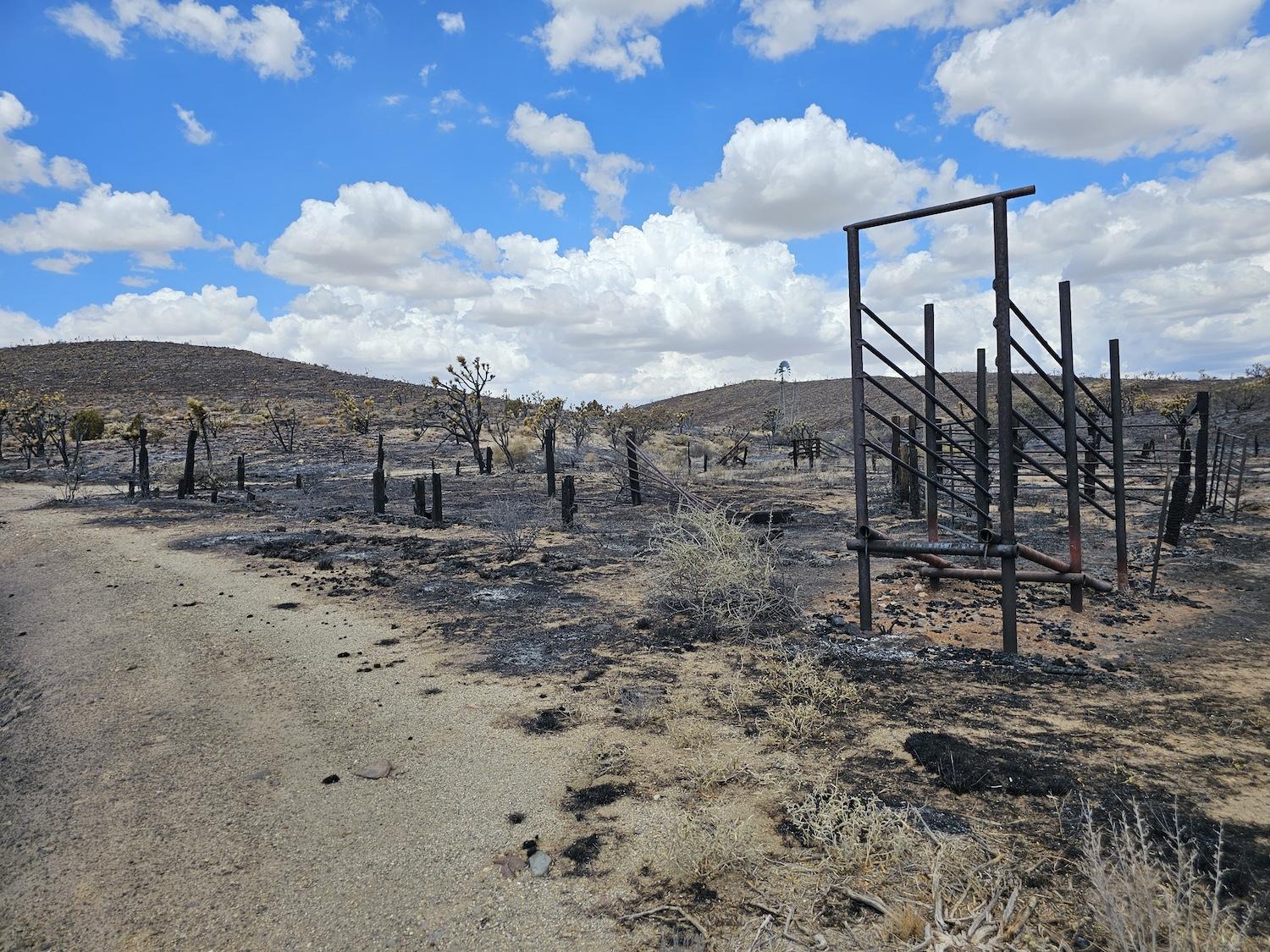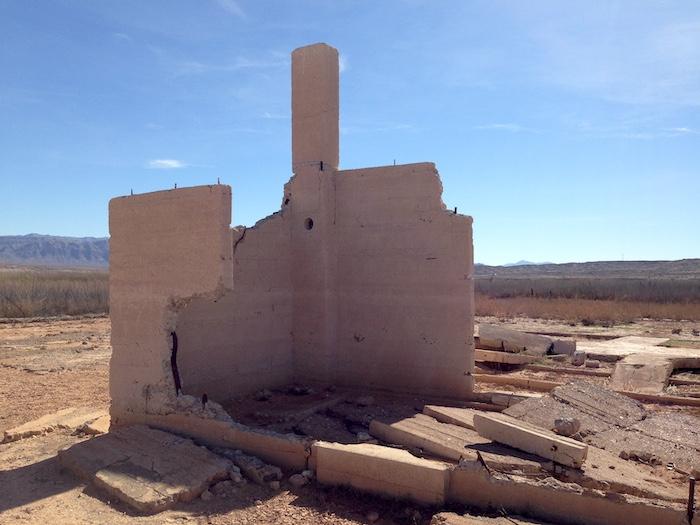
The York Fire in 2023 destroyed the Barnwell Corral at Mojave National Preserve. The corral was listed on the National Register of Historic Places/Jacob Overson
Struggling To Maintain Cultural Resources Against Climate Change Impacts
Intense Storms, Wildfires, And Drought Affecting National Park Resources
By Lori Sonken
Jacob Overson loved growing up on cattle ranches on public land in California’s east Mojave Desert. Without power (except by generator), only two television stations, and no telephone, he enjoyed the radio and exploring mountains. He did homework during the hour-long bus ride to high school. But his pastoral life turned in 1994 when Congress designated the Mojave National Preserve and began curtailing grazing after more than a century.
Overson roped the last cow on Valley View Ranch in 2002 when he was 16. “I was sad to see my livelihood go away. For me the only thing I ever knew was ranching and cowboying,” he said.
Now the ranches that Overson’s extended family formerly owned or managed — Kessler Springs, OX, and Valley View, all listed on the National Register of Historic Places — are again threatened, this time by wildfires. Since 2005, more than 150,000 acres in the the national preserve have burned, taking all of Kessler Springs and portions of Valley View, along with rock art and other historic sites with them.
Wildfires, drought, sea level rise, more frequent and intense storms and hurricanes, and warming ocean temperatures are scouring, sometimes destroying, and occasionally improving or allowing cultural resources to emerge at national park units, according to archaeologists and cultural resource managers across the National Park System.
In south Florida, Joshua L. Murano has seen “devastating changes” caused by the increase in high intensity storms since he joined the National Park Service as an intern in 2012. Now a coastal and underwater archaeologist with national parks in South Florida, he dives into waters surveying, locating, and documenting submerged cultural heritage sites, such as the HMS Fowey British warship which sank in 1748 near what is now Biscayne National Park. From 2012-2015, the National Park Service spent $300,000 burying the ship beneath 16,000 sandbags to prevent erosion. But Hurricane Irma in 2017, followed by Hurricane Ian in 2022, moved the sandbags off the shipwreck.
“Now, we have to rethink how to manage it,” said Murano. Other fragile sites have been buried by sediment and preserved, so the impacts are not always negative, he said.
While the exact locations of most shipwrecks, including the HMS Fowey, are kept secret to guard against looters, the wreck of the 19th century, three-masted Windjammer south of Loggerhead Key at Dry Tortugas National Park protrudes 20-25 feet out of the water, making its location visible to boaters and divers alike. The 261-foot-long by 39-foot-wide iron-hulled vessel sank in 1907 while transporting lumber from Pensacola, Florida, to Montevideo, Uruguay. Details on how this happened remain a mystery.
The site was “previously covered by an absolutely beautiful coral reef, but the coral’s been dying off to the extent that I almost don’t recognize it anymore,” said Murano. Without the coral, the site is more vulnerable to erosion.

Warming ocean waters have bleached elkhorn coral, a threatened species/USGS
Poached Corals
Ilsa Kuffner, a research and marine biologist with the U.S. Geological Survey, is trying to restore the elkhorn coral at Dry Tortugas.
The coral reef acts as a rampart preventing the waves from pummeling Garden Key, but as sea levels rise the protective role diminishes, she explained. Now listed under the Endangered Species Act as a threatened species, the elkhorn coral’s population is declining due to ocean warming, ocean acidification, and coral disease, among other reasons. A paper Kuffner published in 2014 in the peer-reviewed journal, Estuaries and Coasts, showed that ocean temperature during the summer months in Florida increased 1.4 degrees Fahrenheit over the last century, but temperatures vary from year to year.
Since 2009 scientists, including Kuffner, have been trying to promote sexually reproducing coral colonies. They were succeeding until last year’s ocean water heat wave caused the fourth global coral bleaching event. All the elkhorn coral seem to have died at Dry Tortugas, said the biologist, who plans to go back in May to survey the corals to see if any survived.
Kuffner is experiencing “eco-grief,” but believes scientists have no choice but to continue their efforts. They are considering whether to take corals from far away and plant them in park waters or to use selectively bred corals with higher heat tolerance.
A healthy coral reef would also lend some protection to the moat wall surrounding Dry Tortuga's historic Fort Jefferson built in the 1800s and damaged by Hurricane Irma in 2017 and Hurricane Ian in 2022. The park is currently repairing the wall.
Lost To Fire
Back at Mojave National Preserve, Overson, 38, today works for the Park Service, as did his late father, Tim, who wrangled burros once ranching stopped. The 2020 Dome Fire destroyed the water tanks, gas and electric lines at Valley View Ranch where Overson lived as a boy.
“Now, I’m fixing everything to turn it back into park housing,” he said.
Fire has impacted other historic resources too, said David R. Nichols, the preserve’s archaeologist and cultural resources manager. The 2005 Hackberry Fire wiped out Sagamore Mine Tin Camp, a Great Depression-era silver mine found eligible but never put on the national register. Last year’s York Fire burned properties that were listed.
“We lost a cattle scale (made of wood — one of a kind), several corrals, a pasture fence, several wooden fence lines/posts, some of the historically planted trees at the Rock Springs Land and Cattle Company’s headquarters, some of the fence that enclosed that property, and the juniper post fence that enclosed a concrete and rock reservoir,” said Nichols in an email.
Nichols has been coming to the area since he was child in the 1970s. The cultural sites “conveyed a distinct feeling of experiencing life in the late 19th early 20th centuries. It was a sense of being in the shoes of those who made a living out here,” he said.
To try to limit wildfire damage, preserve staff clear vegetation around flammable historic structures to reduce the fuels that carry fire. Structures can also be wrapped in fire-resistant foil when a fire approaches and may reduce the impact of heat and flames, said Nichols.
The Biden administration is funding efforts to protect other cultural sites in the park system from climate change impacts. For example, Acadia National Park received $950,000 for a 5-year-long project “to build a process, a toolbox or handbook or some kind of case book methodology we can share with parks” to address climate change vulnerabilities of coastal archaeological sites, collections, landscapes and ethnographic resources, said Rebecca Cole-Will, the park’s chief of resource management.
Cole-Will is focusing on coastal shell middens or shell mounds, largely made of clamshells, and filled with artifacts and information about the Wabanaki people who lived on the coast. Using a “two-eyed seeing approach” the park is working with Indigenous archaeologist Bonnie Newsom, an associate professor in anthropology at the University of Maine, to create educational and communication materials and map and monitor the 25-35 sites impacted by increases in storm intensity and frequency.
“Two-eye’d seeing is a term coined by Mi’kmaq elder Albert Marshall. It’s an alternative approach to scientific inquiry that brings Indigenous knowledge and mainstream science together to carry out research and make management decisions for the benefit of all. It differs from approaches that use either Western science or Indigenous knowledge exclusively, or an approach that extracts indigenous knowledge to assimilate it into western science without equity," Newsom wrote in an email.
Other park units, including Crater Lake National Park, Oregon Cave National Monument and Preserve, Sequoia and Kings Canyon National Parks, and Yosemite National Park are slated to receive $1.4 million from the Inflation Reduction Act to develop treatments for cultural resources threatened by wildfire.

Ruins of the Hannig Ice Cream Parlor in the ghost town of St. Thomas that has resurfaced at Lake Mead NRA/NPS file
But park managers often do not know where their cultural resources are located. There’s no inventory and monitoring program for cultural and historical resources in the parks as a Traveler podcast recently discussed.
At Lake Mead National Recreation Area, “Native American artifacts and historic artifacts and more modern artifacts have come out of the water as the water has declined and additional shoreline has been exposed during droughts,” said Chris Nycz, the park's cultural resources program manager. Since the early 2000s, when the lake levels began to decline, the former Mormon settlement of St. Thomas emerged, including its foundations for the post office and an ice cream shop, as well as irrigation features. The town existed until Hoover Dam flooded the area.
The national recreation area spreads across 1.5 million acres, but only five percent of the park has been surveyed for cultural resources, Nycz said. It’s possible for park visitors to discover archaeological resources that the two staff archaeologists know nothing about, but it’s illegal to remove them.
“We always urge people to enjoy looking at these artifacts of history or housing remnants or whatever they find but leave all things they find in place. In order to really understand and study and be able to contribute to our understanding of our local history we need everything to be in its exact location, “ Nycz added.

Add comment